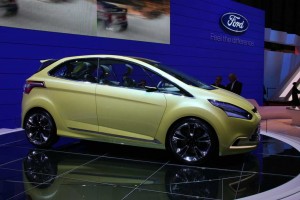
Latest Iosis concept has themes of the next C-Max.
Another Iosis concept car from Ford has arrived at Geneva. It‘s the third model in the Iosis range, that debuted in 2005 with a ‘kinetic design’ that was continued in the second Iosis X Concept in 2006. The latter showed what the Ford Kuga was going to be. The new Iosis Max Concept indicates the design philosophy for future Ford models, starting with the next C-Max. So be prepared to see the trapezoid grille and light emitting diode headlamps in future Fords, and also a sleek profile with strong shoulders.
“The rakish C-pillar combined with the upper spoiler that seems to be floating contributes positively to the critical air flow in the back,” says Martin Smith, executive director of design.
Unique is the rear tailgate that is a two-part construction. The two pieces glide together to create a compact hatch for easy loading. It is not certain that we can expect this heavy construction in production Ford models; nor would we expect the frameless double-hinged front doors or the rear-hinged rear doors that slide backwards anytime soon.
In the interior, the center console sweeps through the car. Nice for a concept like the Iosis Max, where the rear seats are mounted to the console, but unlikely for a production car as you lose the middle seat in the rear. The special construction for the hood that flips up to parallel the wind shield for easy access may be more realistic.

Is it possible that the Focus RS model will emerge as the fastest Ford production car ever?
Despite the economic down turn, Ford of Europe had a busy last year by introducing a revised Focus, the Kugo crossover and the all-new range of small cars with the Fiesta and Ka. Ford will complete the rollout of those models this year in European markets and unveil the Focus RS, said to be Ford’s fastest production model ever. (Have they forgotten the GT 40?)
Ford of Europe is determined to go on with the development of future products. In the meantime, the small Fiesta that was introduced last year is doing so well that Ford of Europe Chairman and CEO John Fleming calls it a cornerstone of the line up.
“Last year we launched the new Fiesta and we were worried about capacity and demand. Now, it is the reverse, we are worried about demand and have to cut capacity. In Europe there is a need for leadership. We need a policy to enable us to make progress together. The countries try to save only their own industry, it’s nationalism and protectionism that is concerning,” says Fleming.
